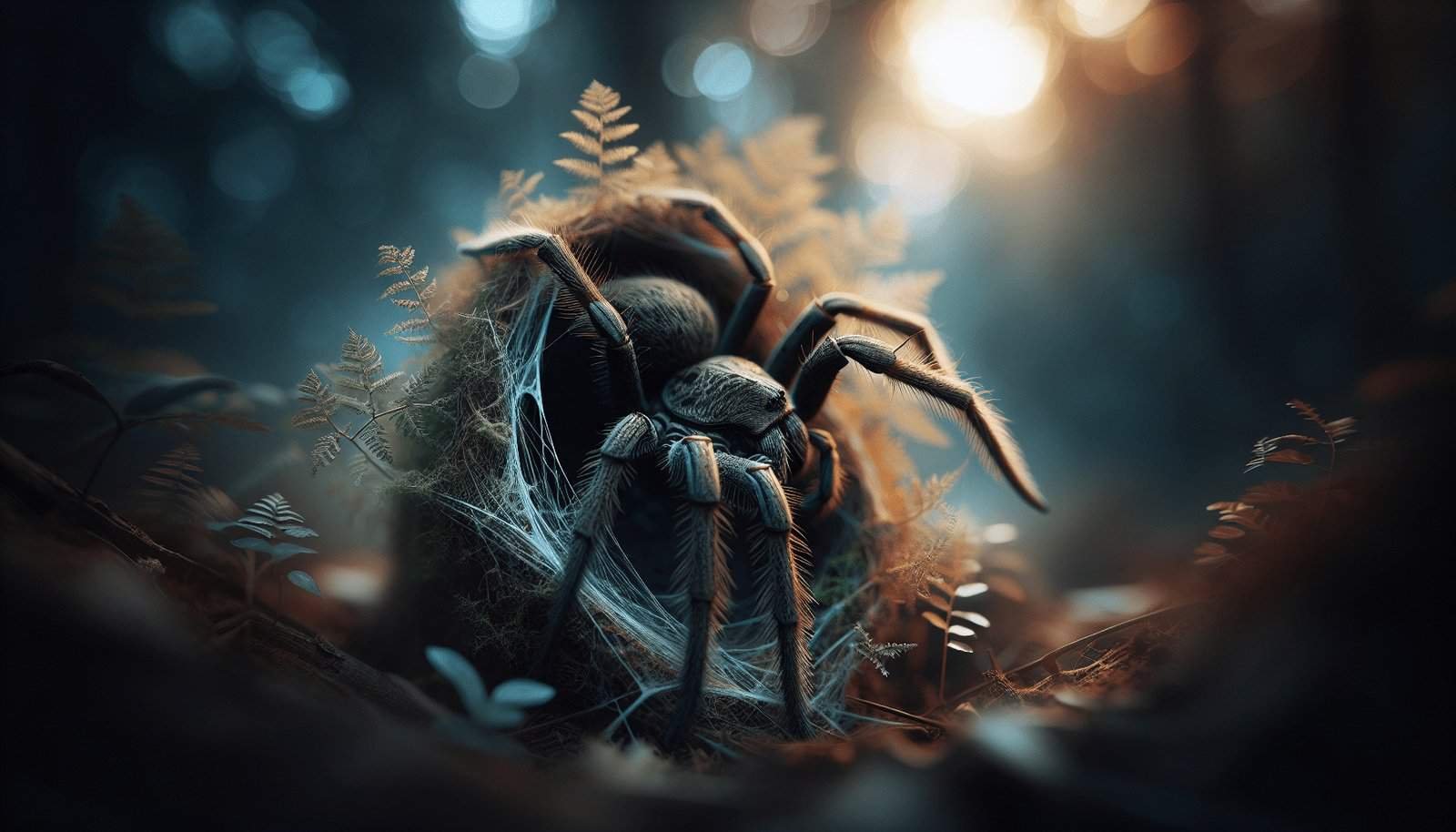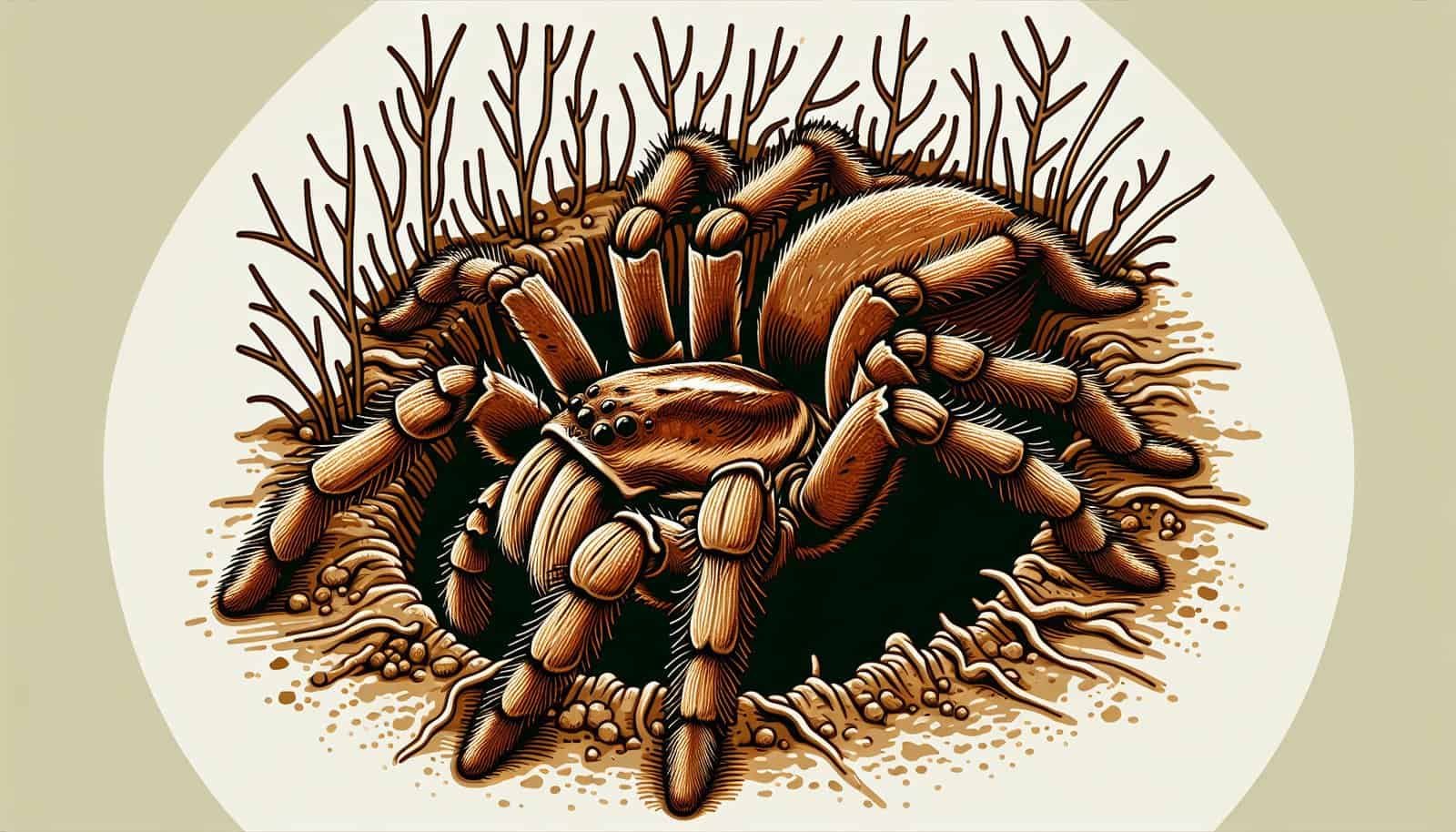Imagine stumbling upon a mysterious creature, shrouded in secrecy and admired for its fascinating traits. Yes, you guessed it right – the elusive Trapdoor spider! In this article, we delve into the captivating world of these remarkable arachnids, uncovering their unique characteristics and unraveling the mysteries surrounding their care requirements. So, grab your magnifying glass and join us on this thrilling adventure as we unveil the hidden wonders of the Trapdoor spider.
Physical Characteristics
Size
Trapdoor spiders are known for their relatively large size compared to other spider species. On average, they can measure between 1 and 3 inches in length, with some species reaching up to 4 inches. However, it is important to note that the size can vary between different species and individual spiders.
Coloration
Trapdoor spiders are typically dark brown or black in color, which helps them blend in with their natural surroundings. This camouflage allows them to remain hidden from predators and unsuspecting prey. They have a glossy appearance, adding to their mysterious allure. Occasionally, they may have lighter markings or patterns on their bodies.
Body Structure
The body structure of a trapdoor spider typically consists of two main parts: the cephalothorax and the abdomen. The cephalothorax is the front part of the spider’s body, which contains the head and legs. The abdomen is the larger posterior portion of the body, where the vital organs are located. Trapdoor spiders have eight legs and a pair of pedipalps, which are used for sensory purposes and mating.
Habitat and Distribution
Preferred Habitat
Trapdoor spiders are predominantly found in terrestrial habitats such as forests, woodlands, grasslands, and deserts. However, their preferred habitat varies depending on the species. These spiders are specifically adapted to burrowing and constructing intricate burrows with trapdoors, hence their name. They prefer areas with loose soil, where they can easily dig their burrows.
Geographical Distribution
Trapdoor spiders can be found in various parts of the world, including North and South America, Africa, Asia, and Australia. Each region may have different species of trapdoor spiders with distinct characteristics and adaptations. Due to their secretive nature and primarily subterranean lifestyle, they may not be commonly encountered by humans, further adding to their elusive reputation.

Behavior and Lifestyle
Burrowing Behavior
One of the most fascinating aspects of trapdoor spiders is their burrowing behavior. These arachnids construct burrows in the ground, which serve as their homes and hunting grounds. They use their strong jaws, known as chelicerae, to create an entrance and build a tube-like structure. The entrance is covered by a hinged trapdoor made of silk and soil, providing the spider with protection and an ambush point for unsuspecting prey.
Feeding Habits
Trapdoor spiders are opportunistic predators, feeding on a variety of small invertebrates like insects, earthworms, and other spiders. They patiently wait inside their burrows until prey wanders close enough for them to detect vibrations. Once the prey comes within reach, the trapdoor spider swiftly strikes, capturing it with its powerful jaws. These spiders are known for their well-timed ambushes and efficient hunting tactics.
Reproduction
Trapdoor spiders reproduce in a manner similar to many other spider species. After a courtship ritual, the male deposits sperm onto a small web, which is then taken up by specialized structures on his pedipalps. The male then approaches the female’s burrow cautiously, often tapping on the trapdoor to signal his intentions. If the female accepts the male, mating occurs within the burrow. The female lays her eggs inside a silk cocoon, which she guards until the spiderlings hatch.
Lifespan
The lifespan of trapdoor spiders can vary depending on the species and environmental factors. On average, they live for several years, with females generally having longer lifespans compared to males. Some species have been known to live up to 20 years. However, the lifespan of individual trapdoor spiders can be influenced by factors such as predation, habitat conditions, and accessibility to food sources.
Trapdoor Spider Species
Different Species
The world is home to a remarkable diversity of trapdoor spider species. Some notable examples include the Brazilian trapdoor spider (genus Ummidia), the Sydney funnel-web spider (Atrax robustus), and the California trapdoor spider (genus Aptostichus). Each species has its own unique characteristics, ranging from varying sizes to distinct behaviors and habitats.
Key Differences
The key differences between trapdoor spider species can be observed in their physical appearance, habitat preferences, geographical distribution, and hunting techniques. Some species may have specific adaptations to their local environment, such as specialized burrowing techniques or different prey preferences. Understanding these differences is crucial for successfully caring for and appreciating the diverse world of trapdoor spiders.

Caring for a Trapdoor Spider
Housing
When considering the care requirements for a trapdoor spider, it is essential to create an environment that resembles its natural habitat as closely as possible. A secure, well-ventilated, and appropriately-sized enclosure is necessary. The enclosure should have enough space for the spider to move around comfortably but should not be excessively large, as it may impede the spider’s ability to construct its burrow.
Substrate
The choice of substrate is crucial in simulating the trapdoor spider’s natural burrow conditions. A mixture of sand and soil can be used to create a suitable substrate that allows for burrowing while maintaining stability. It is important to ensure that the substrate is neither too wet nor too dry, as trapdoor spiders prefer a balance of moisture in their burrows.
Temperature and Humidity
Maintaining the appropriate temperature and humidity levels is vital for the well-being of a trapdoor spider. Their ideal temperature range is usually between 70 to 80 degrees Fahrenheit (21 to 27 degrees Celsius). Additionally, trapdoor spiders thrive in environments with moderate humidity levels, typically around 50 to 70%. It is crucial to monitor these factors regularly to provide the optimal conditions for the spider’s health.
Feeding
Trapdoor spiders primarily feed on live prey. Providing a varied diet consisting of small insects like crickets, mealworms, and flies is essential for their nutritional needs. It is recommended to offer prey once or twice a week, considering the spider’s size and appetite. It is important to remove any uneaten prey after a reasonable amount of time to maintain cleanliness in the enclosure.
Handling
Due to their reclusive nature and defensive behaviors, trapdoor spiders are not typically handled or interacted with like other pets. They are best observed from a safe distance, allowing them to thrive in their burrowing lifestyle. It is crucial to prioritize their welfare and minimize stress, as unnecessary handling can lead to injury or distress.
Potential Health Issues
Mites and Parasites
One potential health issue that trapdoor spiders may face is infestation by mites or other parasites. These unwanted hitchhikers can cause stress, weaken the spider’s immune system, and lead to various health problems. Regularly inspecting the spider’s enclosure and maintaining proper hygiene can help prevent and address these issues.
Malnutrition
Inadequate nutrition can also affect the health of trapdoor spiders. Providing a balanced diet with a variety of live prey helps ensure they receive essential nutrients. It is crucial to monitor the spider’s feeding habits and adjust their diet if necessary to prevent malnutrition.
Injury or Trauma
Trapdoor spiders are relatively resilient creatures, but they are not immune to injury or trauma. Accidental falls, aggressive encounters with other spiders, or disturbances in their burrows can result in physical harm. Creating a safe and secure enclosure, minimizing disturbances, and appropriately structuring the habitat can reduce the likelihood of such injuries.

Conservation and Threats
Habitat Loss
Habitat loss due to deforestation, urbanization, and human development poses a significant threat to trapdoor spiders. As their natural habitats are destroyed or altered, their ability to find suitable burrowing sites and prey diminishes. Conservation efforts should focus on preserving and restoring their native habitats to ensure their survival.
Human Interactions
Trapdoor spiders are generally reclusive and avoid human contact. However, human activities can inadvertently disturb their habitats or lead to their capture and removal. It is important to respect their natural habitat and refrain from unnecessary disturbance or removal of these fascinating creatures.
Threats to Survival
Trapdoor spiders face various threats to their survival, including climate change, pollution, invasive species, and habitat fragmentation. These factors can disrupt their natural behavior, alter predator-prey dynamics, and cause population declines. Researchers and conservationists are working to better understand and mitigate these threats to ensure the long-term survival of trapdoor spiders and their ecosystems.
Interesting Facts About Trapdoor Spiders
Predator Avoidance
Trapdoor spiders have evolved several remarkable adaptations to avoid predators. Their inconspicuous coloration and burrowing habits make them difficult to spot. Additionally, the trapdoor they construct serves as a barrier against potential threats, such as predators or unfavorable weather conditions.
Silk Production
Like other spiders, trapdoor spiders are known for their silk production abilities. They use silk to construct their burrows, reinforce the trapdoor, create egg sacs, and even make draglines for safety when moving outside the burrow. Trapdoor spider silk is renowned for its strength and durability.
Camouflage Techniques
Trapdoor spiders possess exceptional camouflage skills. Their dark coloration helps them blend seamlessly with the surrounding soil or vegetation. Some species even have specialized hairs on their bodies that allow them to mimic dead leaves or other natural debris. These camouflage techniques enable trapdoor spiders to remain hidden and undetected by both predators and prey.

Misconceptions About Trapdoor Spiders
Aggressiveness and Venom
Contrary to popular belief, trapdoor spiders are not inherently aggressive towards humans. They will usually avoid confrontation and retreat into their burrows when threatened. While they do possess venom, it is primarily used for subduing prey rather than self-defense. The venom of most trapdoor spiders is not considered dangerous to humans, although individual sensitivities can vary.
Danger to Humans
Trapdoor spiders do not pose a significant threat to humans. They are not typically aggressive, and their reclusive nature keeps them away from human activity. While defensive behaviors may be observed if a spider feels threatened, they are generally harmless when left undisturbed. It is important to remember that respecting their natural habitats and observing them from a safe distance is the best way to appreciate these fascinating creatures.
Conclusion
Trapdoor spiders are remarkable creatures with fascinating characteristics and unique care requirements. Their large size, dark coloration, and intricate burrowing habits make them a captivating addition to the world of arachnids. By providing suitable housing, replicating their natural habitat, and respecting their needs, we can provide these elusive creatures with a nurturing environment in captivity. It is our responsibility to conserve their natural habitats and raise awareness about their ecological importance. Through understanding and appreciation, we can ensure the long-term survival of trapdoor spiders and continue to unravel the mysteries surrounding these enigmatic arachnids.
